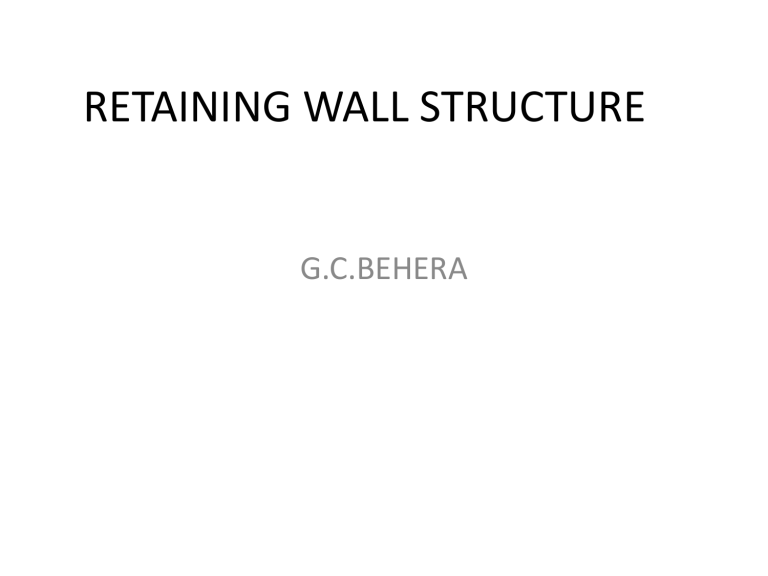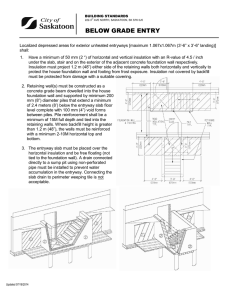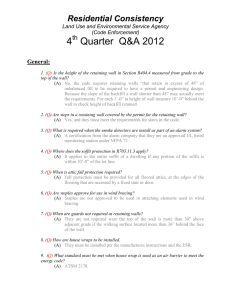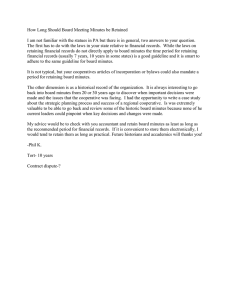
RETAINING WALL STRUCTURE
G.C.BEHERA
TYPES OF RETAINING WALL STRUCTURES
• USED FOR
Construction of basement of buildings.
Abutment of bridge construction
Construction of Embankment
TYPES OF RETAINING WALL
1. Gravity retaining walls
2. Semigravity retaining walls
3. Cantilever retaining walls
4. Counterfort retaining walls
Gravity retaining walls
are constructed with plain concrete or stone masonry. The stability will be by
their own weight and any soil resting on the masonry for stability. This type of
construction is not economical for high walls.
semi gravity walls
When some reinforcement is added to gravity type to make it economical, it is
known as semi gravity type.
Cantilever retaining walls;
These are made by providing
reinforcement which makes the
stem thin. This is more
economical for ht up to 8m.
Counterfort retaining walls:
Cantilever
retaining
walls
provided with vertical concrete
slabs at regular intervals(known
as counterforts) are known as
counterfort retaining walls.
Counterforts are provided to
minimize shear and the bending
moments.
DESIGN PARAMETERS:
the unit weight, angle of
friction, and cohesion-for the
soil retained behind the wall ,
and the soil below the base
slab.
DESIGN STEPS
These retaining wall structures should checked for stability. That includes
checking for possible overturning, sliding, and bearing capacity failures.
Second, each component of the structure is checked for adequate strength, an
When designing retaining walls, an engineer must assume some of the
dimensions, called proportioning, which allows the engineer to check trial
sections for stability. If the stability checks yield undesirable results, the sections
can be changed and rechecked. Figure shows the general proportions of various
retaining walls components that can be used for initial checks. d the steel
reinforcement of each component is determined.
• Note that the top of the stem of any retaining wall should not be less than
about 12 in.(≈0.3 m) for proper placement of concrete. The depth, D, to the
bottom of the base slab should be a minimum of 2 ft (≈0.6 m). However, the
bottom of the base slab should be positioned below the seasonal frost line.
• For counterfort retaining walls, the general proportion of the stem and the
base slab is the same as for cantilever walls. However, the counterfort slabs
may be about 12 in.(≈0.3 m) thick and spaced at center-to-center distances of
0.3𝐻𝐻 to 0.7 𝐻𝐻.
•
•
•
Active earth pressure tends to deflect
the wall away from the backfill.
active earth pressure for horizontal &
cohesion less soil
active earth pressure for inclined back
fill & cohesion less soil
•
• Passive earth pressure for
horizontal & cohesion less
soil
• Passive earth pressure for
inclined back fill & cohesion
less soil
is the angle of internal friction or angle of repose
is the angle of backfill
D min0.6m
•
•
•
•
•
1. Check for overturning about its toe
2. Check for sliding along its base
3. Check for bearing capacity failure of the base
4. Check for settlement
5. Check for overall stability
• The factor of safety against overturning about the toe-that is, about
point C
For calculation of the resisting moment, Σ 𝑀R
Note that the force 𝑃𝑣=also contributes to the resisting moment. 𝑃𝑣 is the
vertical component of the active force 𝑃𝑎
STABILITY REQUIREMENT
• (1) OVERTURNING
A retaining wall is subjected to over turning moment under the action of
lateral force developed due to lateral earth pressure, which try to overturn the
wall about the toe end. The overturning moment (M0) is given by
M0=Pah*H/3=(1/2)(KaH)*H*H/3=(Ka* H3/6)
The resisting moment (MR) is provided by weight of the backfill , surcharge
and self weight of the retaining wall. If W is the resultant vertical load made
up of self weight of the retaining wall and weight of the backfill on the base
slab, then resisting moment is
𝑀𝑅 = 𝑊 ∗ 𝑥ҧ
𝑥ҧ is the position of the resultant vertical load (𝑊) from the toe end.
As per the Code- IS 456 : 2000 Clause 20.1, the stability of the retaining wall
against overturning should be ensured that resisting moment should not be
less than 1.4 times the maximum overturning moment. If the dead load
provides restoring moment , then as per code 90% of the dead load should be
taken into account.
𝑓𝑠1 =
0.9𝑀𝑟
𝑀0
𝑓𝑠1 ≥ 1.4
0.9(σ 𝑊∗𝑥ҧ
𝐾𝑎 𝛾𝐻3
6
≥ 1.4
SLIDING
The lateral earth pressure tries to slide the retaining wall from the back
fill. Frictional force between base slab and soil opposes this. If is the
frictional coefficient betwwen concrete and soil , then frictional force
of resistance
𝐹𝑅 = 𝜇 𝑊
The lateral force causing sliding
𝐾𝑎 𝛾𝐻 2
𝐹𝑠 = 𝑃𝑎ℎ =
2
Safety factor against sliding (fs2) is taken as 1.4 and only 0.9 times of
Characteristic load should be taken.
𝐹𝑅 𝜇 σ 𝑊
𝑓𝑠2 =
=
𝐹𝑠
𝑃𝑎ℎ
0.9(𝜇 σ 𝑊)
≥ 1.4
𝑃𝑎ℎ
If the criteria is not satisfied , provide shear key.
PROPORTIONING OF CANTILEVER RETAINING WALL
Before the actual analysis, there is requirement for fixing of dimensions.
Depth of Dimension
1) Depth of Foundation
ℎ𝑚𝑖𝑛 =
𝑞0 1+𝑠𝑖𝑛𝜑 2
𝛾 1−𝑠𝑖𝑛𝜑
Where H min is the depth below the ground level, q0= Safe bearing capacity,
Is unit weight of soil and is the angle of repose.
2) Height of the retaining Wall (H)
H=h+hmin where h is height of material to be retained.
3) Base width(b)
Width of the base slab can be determined by considering equlibrium of
various forces at the base. Base width varies from 0.4 H to 0.6H.
4) Thickness of Base slab
For the Preliminary analysis, thickness of the base slab can be taken H/10 to
H/15. H is the total ht of the retaining wall. Min thickness not less than 300
mm. Thickness assumed should be checked from bending moment and shear
force requirement.
• Thickness of Stem
• Thickness of the vertical stem is governed by moment criteria. It behaves
like a cantilever. It is better to have trapezoidal section , 150 mm depth at
topand at the base not less than 300 mm. Initially the stem may be
assumed to be 8% to 10% of the total height of the retaining wall.
• Structural Behavior of Components of a Cantilever Retaining Wall:
1) STEM:
• It behaves like a cantilever.
• Maximum moment at the base B
• M0=Pah*h/3=(1/2)(Kah)*h*h/3=(Ka* h3/6)
2) Heel Slab
The heel slab acts as a cantilever. It is subjected
to upward soil pressure and downward pressure due to earth fill. Backfill
pressure generally more, so tension in top face BC.
3) Toe Slab:
This also behaves like a cantilever. Weight of the front fill is less, so bottom
face is subjected tension. Reinforcement is to be provided along GF.
Problem: Design a cantilever retaining wall to retain the horizontal earthen
embankment of a ht. 4 mt. above the ground level. Unit weight of backfill 18 kN/m3,
angle of repose 300, sbc 180 kN/m3, coefficient of friction between concrete and soil
0.45. Use M20 concrete and Fe415 steel.
Solution: Coefficient of active earth pressure Ka
1 − sin ∅
𝐾𝑎 =
= 1/3
1 + sin ∅
Minimum Depth:
ℎ𝑚𝑖𝑛 =
𝑞0 1−𝑠𝑖𝑛𝜑 2
𝛾 1+𝑠𝑖𝑛𝜑
=
180
18
1/3
2
= 1.11 𝑚 𝑠𝑎𝑦 1.2 𝑚
Total height of the wall= Depth of foundation + height of embankment
=1.2+4=5.2 m
Preliminary Dimension of the Retaining Wall:
1) Base width: b= 0.4H to 0.6H Take b=2.8 mt
Length of Toe= 0.3b to 0.4 b Take =850 mm
2) Thickness of base slab= Assuming H/10, Take 500 mm
3) Thickness of stem:
𝐾𝑎 𝛾ℎ3
𝑀𝑜𝑚𝑒𝑛𝑡 𝑎𝑡 𝑡ℎ𝑒 𝑏𝑎𝑠𝑒 =
= 103.83 𝑘𝑁𝑚
6
•
•
•
•
•
Ultimate Moment Mu=1.5*103.83=155.74 kNm
MU=.138*fck*b*d2
d= SQRT[Mu/(0.138*fck*b)]=238 mm
Assuming 60 mm cover =238+60=298 mm
Take depth at base of stem 350 mm and 150 mm
at the top.
Forces acting in Retaining Wall
TYPE OF FORCE
Magnitude of Force Position of force
(kN)
from “O”
Bending Moment at
Toe end “O” (kNm)
(1) Pah=( ½) Ka**H2
0.5*(1/3)*18*5.2*5.2=81.12
H/3=1.733
81.12*1.733=140.61 M0=140.61
1.6*4.7*18=135.36
2.8-1.6/2=2.0
270.72
0.15*0.4.7*25=17.625
0.85+0.35-0.15/2=1.125
19.828
1.5*0.2*4.7*25=11.25
0.5*2.8*25=35
0.85+2/3*0.2=0.983
2.8/2=1.4
11.554
49
(2) Restoring Force
a) Wt of Back fill (W1)
b) Wt. of Stem
i) Wt of rect. Portion(W21)
ii) Wt of Triangular
portion(W22)
c) Wt of Base Slab (W3)
W=199.735
351.1
Stability Check:
Overturning:0.98MR/M0=0.9*351.10/140.6
1=2.2>1.4 So OK.
Stability Check: 0.9FR/FS1.4
FR=W=0.45*199.735=89.88 kN
FS=Pah=81.12 kN
0.9*FR/FS=0.9*89.46/81.12=0.99<1.4
Provide Shear key.
Base Pressure:
Resultant Moment at Toe end O=MR-M0
=351-140.61=210.49 kNm
The resultant of the vertical load=199.73
kN
This acts at a distance x from the toe end
210.49
𝑥ҧ =
= 1.05 𝑚
199.73
Eccentricity=e=b/2-x=1.4-1.05=0.35 m
Maximum eccentricity=b/6=2.8/6=0.466 m
Maximum Pressure at toe end=𝑝𝑚𝑎𝑥 =
124.83𝑘𝑁
𝑚2
𝑘𝑁
𝑊
𝑏
< 180 𝑚2
Minimum Pressure at heel end= 𝑝𝑚𝑖𝑛 =
17.83𝑘𝑁
𝑚2
𝑘𝑁
1+
𝑊
𝑏
6𝑒
𝑏
1−
=
6𝑒
𝑏
199.73
2.8
=
1+
199.73
2.8
6∗0.35𝑒
2.8
1−
=
6∗0.35𝑒
2.8
=
< 180 𝑚2 and compressive
Design of Stem: D=350 mm, d=350-60=290 mm
Moment at the base=155.73 kNm
Area of Steel Ast
𝑓𝑦 𝐴𝑠𝑟
𝑀𝑢 = 0.87𝐴𝑠𝑡 𝑓𝑦 𝑑[1 − 𝑓
𝑐𝑘 𝑏𝑑
]
Putting the values, Ast required= 1693 mm2
Using 16 mm dia bars spacing 201*1000/1693=118 mm
Provide 16 mm dia bars @100 mm c/c.
Distribution steel @0.12%
Ast=0.12*1000(150+350)/(2*100)= 300 mm2
Using 8 mm dia bars spacing 167.5 mm, provide 150 mm c/c in inner face, in both
the directions at outer face.
Check For Shear
The critical section for shear at a distance d effective from the base of the stem i.e,
h=4.7-0.29=4.41
Shear force at this level=(1/2)*(1/3)*18*4.41*4.41=58.3 kN
Vu=58.3*1.5=87.52 kN
Normal shear stress= vu=Vu/bd=87.52*1000/(1000*290)=0.3 N/mm2
Pt=201*(1000/100)*1000/[1000*290]=0.69 %
c=0.54 N/mm2 >vu
Curtailment of Reinforcement
As the beam behaves like a cantilever, reinforcement may be curtailed
For 16 mm dia bars ld= 0.87*fy*/[4*bd]=0.87*415*16/(4*1.2*1.6)=752 mm
Curtail the bar after 1000 mm from stem
Total depth at this portion=150+[200*3700/4700]=307 mm
Effective depth=307-60=247 mm
Moment at a depth 3.7 m from top=(1/6)*(1/3)18*3.73=50.7 kNm
Mu=1.5*50.7=76 kNm
𝑓𝑦 𝐴𝑠𝑟
𝑀𝑢 = 0.87𝐴𝑠𝑡 𝑓𝑦 𝑑[1 − 𝑓
𝑐𝑘 𝑏𝑑
]
Steel required for this is 924 mm2.
Spacing of 16 mm dia bars=201*1000/924=217 mm c/c
Hence half of the bars can be curtailed after 12 * dia=12*16=192 mm or development
length,Hence curtailment can be done 1.3 m from base or 3.4 from top.
Another curtailment can be done at 1.5 from top.
Factored Moment at this section=1.5*[18*1.53/(3*6)]=1.5*3.375=5.1 kNm
Overall depth at this section=150+200*3200/4700=286 mm
d= effective depth=286-60=226 mm
𝑓𝑦 𝐴𝑠𝑟
A st required=𝑀𝑢 = 0.87𝐴𝑠𝑡 𝑓𝑦 𝑑[1 − 𝑓
𝑐𝑘
2<A
]=65
mm
stmin=300 mm2
𝑏𝑑
Curtail another half of the bar at 1.5 mt from top, provide 16 mm dia bars 400
mm c/c.
Design of Heel Slab:
Weight of earth supported on heel=18*4.7=84.6 kN/m
Self weight of base slab=0.5*1.0*25=12.5 kN/m
Total load=97.1 kN/m
Maximum bending at B
=(97.1*1.6*1.6/2)-(17.83*1.6*1.6/2)-(1/2)*(78.4-17.83)*(1.6)*(1.6/3)=75.7 kNm
Mu=1.575.7=113.6 kNm
Dreq=SQRT[113.6*106/(2.76*1000)]=202 mm < 440 mm Hence OK.
Area of steel Ast= 741 mm2
Spacing of 12 mm bars=113*1000/741=152 mm
Provide 12 mm dia bars 150 mm c/c.
Distribution steel=0.12*1000*500/100=600 mm2
Provide 10 mm dia 100 mm c/c
Design of Toe Slab:
Neglecting the weight of the front fill above the toe slab,
Maximum moment=[92.35*0.85*0.85/2]+(1/2)(124.8393.35)*0.85*(2/3)*0.85=41.2 kNm
Mu=1.5*41.2=61.8 kNm
Ast required for this moment taking d=440 mm
Ast=396 mm2 < [Astmin=600 mm2 ]
Provide 8 mm dia 100 mmc/c for Astmin.
Design of Shear key
Pressure at face of shear key=92.35 kN/m2
Coefficient of passive earth pressure=3
Let the depth of shear key=a
Resistance offered by shear key=3*92.35*a
Factor of safety against sliding along with shear key
0.9∗𝜇 σ 𝑊+277.05𝑎 0.9∗89.88+277.05𝑎
=
=1.14
𝑃𝑎ℎ
81.12
a=0.118 m
Provide shear key=200 mm X 200 mm.
Detailing of the reinforcement is given below.
COUNTERFORT RETAINING WALL
Dr.G.C.Behera
When ht. Is more than 6 mt., Counterfort retaining walls are preferred. As ht.
Increases, the BM also increases, so Counterfort retaining walls are preferred.
The structural behaviour of counterfort retaining wall is different from cantilever
retaining wall. As the counter supports the stem and heel , they behave like
continuous slabs.
(1) Design of Stem: The stem of counterfort retaining wall acts as a continuous slab
supported on counterforts which are spaced 3 to 3.5 m along the length of
retaining wall. The stem is subjected to earth pressure which tries to deflect the
wall away causing tension on the outer face and compression in inner face. Main
reinforcement is put on the outer face along the retaining wall. Due to fixity
provided by counterfort supports, some negative BM develops which cause
tension in inner face near the counterforts. So, main reinforcement may be
provided in inner face near counterforts. Maximum BM occurs at the base of the
stem.
The load at the base per 1 m length w= Pa*1*1=Ka**H per mt. length.
Bending moment varies wl2/12 at support and wl2/16 at mid span.
(2) Design of Counterfort:
The counterforts are attached to stem and Hell slab.They act as T beams with varying
cross section. Maximum depth near base . The earth pressure acting on stem tries to
separate counterforts from stem. So, horizontal ties are required to hold stems with
counterforts. The downward weight of backfill on heel try to separate heel from
counterfort. Ties are also provided to connect heel and counterfort. Counterforts act
like T beam supported on edges AB and BC, free on edge AC. Thickness of
counterfort may be taken as thickness of the base slab.
Counterforts are designed for a maximum bending moment
Mmax=Ka**h3*l/6
where l is spacing of counterforts
(3)Design of Heel Slab
The heel slab behaves like stem. It is supported on three edges, counterforts, and stem
and acted upon by downward backfill and upward soil pressure. If p is the net
pressure, then p acts in downward direction, the maximum negative moment occurs
at the counterforts pl2/12 and positive moment pl2/16 in the middle of heel slab.
(4) Design of Toe Slab:
Design of toe slab is same as cantilever retaining wall.
PROBLEM: Design a counterfort retaining wall for the following data with M20
concreteand Fe415 steel
= 15 kN/m3
=300
=0.6
h=4 mt
Q0=200 kN/m3
Minimum depth of foundation: ℎ𝑚𝑖𝑛 =
ℎ𝑚𝑖𝑛 =
𝑞0 1−𝑠𝑖𝑛𝜑 2
𝛾 1+𝑠𝑖𝑛𝜑
=
𝑞0 1−𝑠𝑖𝑛𝜑 2
=1.48
𝛾 1−𝑠𝑖𝑛𝜑
200
0 )/(1+sin300 )⌋^2
⌊(1-sin30
15
Overall depth=4+1.5=5.5 m
mt
Proportioning of Retaining wall: Width of base slab=0.6H; take b=3.0 m
Assuming thickness of base slab=H/12= say 500 mm
Toe projection=0.3b= say 0.9 m
Spacing of counterforts=3.0 m
Width of counterfort=0.05H say 300 mm
Thickness of stem = H/20 say 300 mm.
Stability Check:
(1) Overturning.
Factor of safety against overturning:=0.9MR/Mo=0.9*374.6/138.65=2.4> 1.4 so
ok.
(2) Sliding: Safety factor against sliding:
0.9*σ 𝑊/𝐹𝑠=[0.9*0.6*210]/[75.625]=1.49 > 1.4 so ok.
(3) Base Pressure Check: Net Moment at the edge
=MR-MO=374.06-138.65=235.41 kNm
Resultant force distance 𝑋ത = 𝑁𝑒𝑡 𝑀𝑜𝑚𝑒𝑛𝑡/ σ 𝑊 =235.41/210=1.121 m
e= b/2-𝑋ത =3.0/2 -1.121=0.379 m< (b/6=0.5 m)
𝑊
6𝑒
210
6∗0.379
Maximum Pressure at toe end=𝑝𝑚𝑎𝑥 = 𝑏 1 + 𝑏 = 3.0 1 + 3.0 =
123.06 𝑘𝑁
𝑚2
𝑘𝑁
< 200 𝑚2
Minimum Pressure at heel end= 𝑝𝑚𝑖𝑛 =
16.94𝑘𝑁
𝑚2
𝑘𝑁
< 200 𝑚2 and compressive
𝑊
𝑏
1−
6𝑒
𝑏
=
210
3.0
1−
6∗0.379
3.0
=
Design of Stem
Max. horizontal pressure at the base=ph=(1/3)*15*5=25 kN/m2
Stem acts as slab supported on counterforts w==25*1=25 kN/m
Maximum negative moment at counterforts=wl2/12=25*32/12=18.75 kNm
Mu=1.5*18.75=28.125 kNm
Max. positive factored moment at mid span Mu=1.5*wl2/16=1.525*3*3/16=21.1 kNm
Depth Check= d= SQRT{Mu/Ru.b}=SQRT{28.12*106/(2.76*1000)}=101 mm
Assuming effective cover 50 mm
d provided=300-50=250 mm > 101 mm so ok.
Area of steel required
28.125*106=
0.87*415*Ast*250[1-415*Ast/(20*1000*250)]
=320 mm2
Ast min =0.12*1000*300/100=360 mm2
Using 10 mm dia bars spacing 78.5*1000/360=218 mm
Provide 10 mm dia bars 200 mm c/c in both directions all along the height of the stem.
Increase the spacing to 300 mm near the top as pressure decreases.
Shear Check: Maximum factored shear force at face of the
counterfort=Vu=1.5*25*(3.0-0.3)/2=33.75*1.5=50.625 kN
c=Vu/bd=50.625*1000/(1000*250)=0.2 N/mm2
pt=0.157%
c=0.28 N/mm2
c> v so ok





